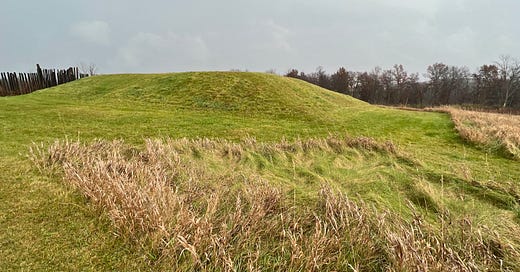This is the last Finding Out issue of 2022! Issues will resume in January, and I hope you, too, will make some time for rest at the end of this year. We certainly all need it.
Walking from Cahokia’s borrow pits to the Twin Mounds, I caught up with the hiker who had said he was from Wash U. Of thirty people on the nature hike, he and his companion were the only two who looked to my eyes to be of native heritage.
Around us, the world was shifting from summer to fall. The dogwood leaves were beginning to turn red, and deer grazed near us in the prairie along the woods. Our feet trod newly mown grass paths.
Ahead of us and to the right, the Twin Mounds rose over three dozen feet from the earth. Nearest us was the first mound of the pair, with its flat top that likely supported a ceremonial building. Ahead was its partner, a burial mound with a rounded top.
While I had joined the hike to get outside and be with other people, my researcher mind immediately perked up when I had overheard this hiker talking about his work at the Buder Center for American Indian Studies. Here in this season—when I had paused my quest to find material about and to support the descendants of the local native people—I could sense a lead.
So, initial greeting out of the way, I observed aloud, “It’s so easy to find information about prehistoric native people in this area; yet it is so hard to learn about historic native people.”
Rather than take my implied invitation to complain, he said, “Well, it is all connected.”
He reminded me that when the Mississippians left Cahokia in 1350 C.E., they spread and shifted into new cultures, including the Osage and the tribes of the Illini. Learning about prehistoric Cahokians is learning about the people who cared for this land just as much as learning about historic native people.
Thrown by this now obvious perspective, I realized my mistake. Even in my direct attempts to decolonize my understanding of my home, I had brought the transactional nature of my culture along with me. Before my conversation with this fellow hiker, I thought that because I couldn’t pay land taxes to prehistoric Cahokians, learning about them was outside my project. But that view of the project, one where I was aiming only to find to whom I could send some money—while important—isn’t the only meaningful part of what I'm trying to learn.
Chelsey Luger described on a recent episode of Life Kit, “My Lakota ancestral teachings have a phrase called mitakuye oyasin, which means ‘we are all related’ or ‘all my relatives.’ And it means that everything is connected: living and non-living, humans, plant life, animal life. Everybody is a part of this greater web, and nobody is greater or less than anybody else.”
I, too, want to feel these connections, to recognize where we’re all from, and to live in a way that honors the interconnectedness of our world.
Ultimately, the person from the Buder Center at the Cahokia hike did tell me about a document he'd made that traced movements of the native people—both prehistoric and historic—in the St. Louis area. I am delighted to have it, because he has carried out the task that I found so intellectually intimidating: to read the individual tribes' accounts of their journeys through today's Midwest.
A few weeks after the Cahokia hike, I walked along a trail at Aztalan. It's about a 30 minute drive from Madison, Wisconsin, and was more or less on the way to Minneapolis and St. Paul, where I was headed to visit friends.
As thunderclouds loomed in the distance, I marveled at the remains of a mound city along the Crawfish River. Here were four platform mounds and a series of conical marker mounds, all within a 22 acre grassland that I could see with one sweep of my head. Somehow, being able to see all of it at once helped it feel even more incredible and real than my experiences visiting Cahokia.
The paths through Aztalan feature illustrated signs explaining what archaeologists think life was like when people lived there. Halfway through my hike, I read that the site had been occupied on and off for 10,000 years. For ten thousand years, there had been humans, people like me, growing and eating and learning and loving and fighting in this space, on this single spread of earth.
For a moment, the big intractable problems of our present fell away. For a moment, I could feel all our ancestors behind us, reassuring us that we are connected and we can continue.
Learning about native people has gained an even deeper meaning for me now. I’m no longer motivated exclusively to atone for the continued impact of my ancestors’ actions. Now, I seek this information both to atone and to feel more deeply connected to our land, our present, and our futures.
Mentioned in this issue: Cahokia Mounds; the Buder Center for American Indian Studies at Washington University in St. Louis; “Connect with your ancestors” on NPR’s Life Kit; “Indigenous Land, Peoples and History of Missouri Brief” from the Buder Center; Aztalan State Park.




